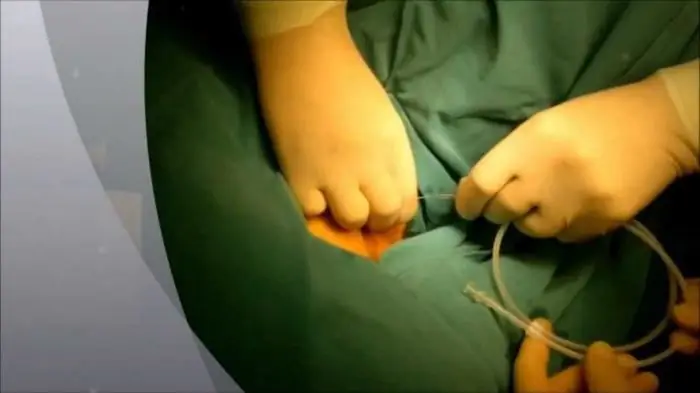- Author Curtis Blomfield [email protected].
- Public 2023-12-16 20:44.
- Last modified 2025-01-23 17:01.
When a person is injured or during surgery, sometimes it is difficult for him to expectorate sputum from the respiratory tract on his own. For this, there is a special medical instrument - an aspiration catheter. Its use greatly facilitates the work of medical staff.

Destination
The concept of "aspiration" - the effect of "sucking" that occurs when creating a reduced pressure. It is also often used for procedures where vacuum is required for sampling body fluids.
During operations or in the postoperative period, a special medical instrument is inserted into the patient's throat - an aspiration catheter. It is necessary in order to remove sputum from the respiratory tract, since a person cannot do this on his own. Catheters are intended for cleaning the trachea and bronchi of the patient. The devices are absolutely safe.
When a patient is on artificial lung ventilation, when he cannot breathe without a tracheostomy or bronchotracheal tube, his airways are filled with sputum and mucus. An aspiration probe is used to remove them. It depends on its quality how much the pumping proceduresecretions will be effective and safe for the patient.
Catheter setup
The suction catheter consists of three functional parts: body, atraumatic end and connector. Let's take a closer look at each part.

Body. It is a transparent tube of white colorless plastic about fifty centimeters long. Specially treated to facilitate entry into the airway, the surface makes the catheter satin-smooth. The catheter should not be too elastic, hard, but not too soft. In the first case, it can scratch the mucous membrane of the trachea. In the second - stick together when sucking sputum. The catheters are equipped with radiopaque bands to determine the position of the device in the human body.
Atraumatic end. Serves for sanitation. Rounded and machined to prevent damage to the walls of the tract. Just above it are two oval holes designed for additional mucus drainage.
The suction catheter has one more part - the connector. It is located at the opposite end of the tube and is connected to the aspirator. The latter is intended for suction of mucous masses. Thus, the connector is a valve for regulating the pressure in the suction tube. A finger press is enough to regulate the suction process.
Connectors are available on the market in several types. A reference point for determining the diameter of the catheter is its color. The smallest is green and the largest is yellow.

Safety
The suction catheter with vacuum control must be used in a safe manner. In diameter, it should be half the size of the airway, otherwise the patient may simply suffocate.
During insertion, the suction must be turned off. Then it turns on for five seconds, turns off and starts working again for the specified time. Only at such intervals is sputum suction allowed.
When using a closed suction catheter, it can be left in the breathing circuit for up to twenty-four hours.
Benefits
The use of such a modern medical instrument as an aspiration catheter helps medical personnel in their work, facilitates the necessary procedures, monitoring the condition of patients. But at the same time, such equipment requires professional knowledge and skills. It is unacceptable to be used by a person who is completely unfamiliar with it.






